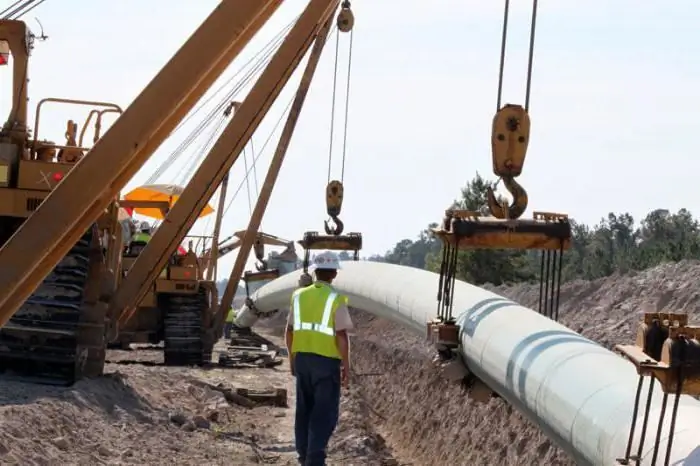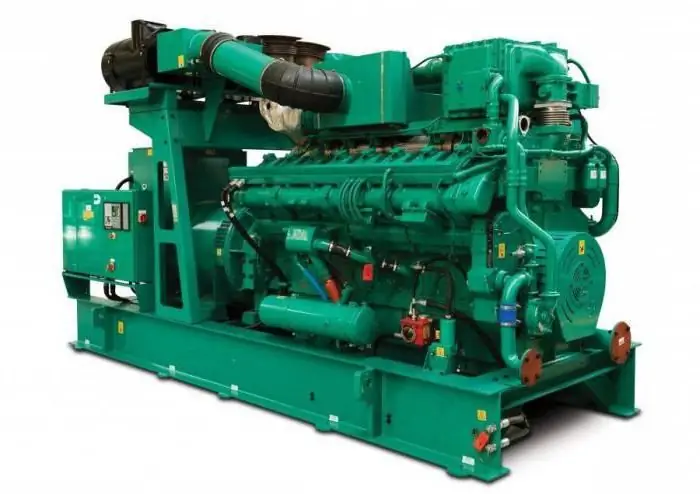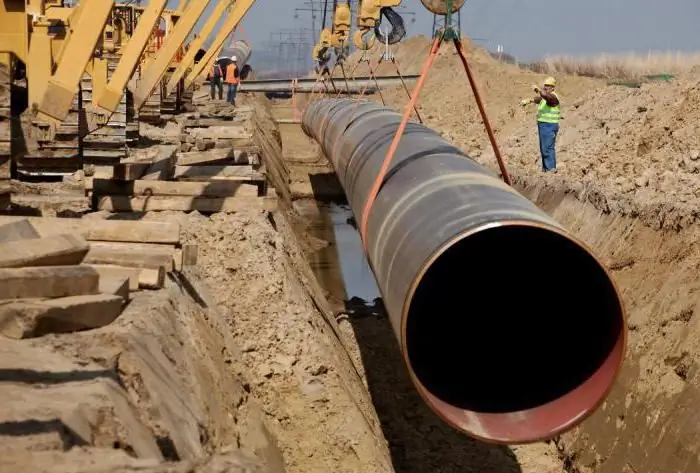2025 Author: Howard Calhoun | [email protected]. Last modified: 2025-01-24 13:10:43
Russia and China are becoming close partners both in the economy and in the foreign policy arena. Large-scale agreements are concluded between the states in terms of cooperation in the field of business. These include a gas contract for the supply of blue fuel to China through the Power of Siberia pipeline.

What are the most notable facts about this project? What is the plan for the planned delivery of gas from Russia to China?
Basic information about the project
The Power of Siberia gas pipeline is supposed to be laid in China from Yakutia. The largest cities through which it will pass are Blagoveshchensk, Khabarovsk, and Vladivostok. The Power of Siberia project is among the top priorities for Gazprom. Relevant work will be carried out both on the Russian and Chinese sides. The gas pipeline will unite the fuel distribution systems in the Irkutsk and Yakutsk gas production centers. It is noteworthy that the name of the project - "The Power of Siberia" - was determined by the Russian Federation based on the results of the competition.

It is assumed that the first section of the pipeline - from Yakutia to Khabarovsk, and then to Vladivostok - will be put into operation by the end of 2017. CanIt should be noted that the route of the gas pipeline will run along the route of the oil pipeline running from Eastern Siberia towards the Pacific coast. This will significantly reduce the cost of building the necessary project infrastructure and energy supply.
Gas pipeline characteristics and scheme
The Power of Siberia project involves the construction of a gas pipeline with a length of about 4,000 km. It will be used to bring natural gas, as we noted above, from two production centers at once - Irkutsk and Yakutsk, towards Khabarovsk. It is expected that the gas pipeline will become a powerful stimulus for the economic development of not only the Far East, but also the Asian part of the Russian Federation as a whole. This will be possible not only due to the growth of direct revenue and the creation of jobs at gas production and transport enterprises, but also due to the increase in the level of gasification of settlements and, as a result, opening up opportunities for launching new industries. These processes will be further stimulated through budgetary support, in particular, provided under the gas supply development program in Primorsky Krai.
The Power of Siberia gas pipeline map looks like this.

We see that the project implementation scheme involves the coverage of a vast territory. It will also be interesting to study the economic scale of the project.
Economic scale
The Power of Siberia gas pipeline is one of the largest projects in the history of the economic development of modern Russia. As you know, between the Russian Federation and the PRC wasa major gas contract was signed, as a result of which Gazprom was able to enter a new market with huge potential. According to some reports, Russia will have to supply China with about 1 trillion cubic meters of gas for a total amount of about $400 billion. For comparison: Russia's GDP at PPP is about $3,500 billion. It is known that Gazprom's counterparty, China National Petroleum Corporation, will make an advance payment of about $25 billion before fuel supplies begin. The estimated throughput capacity of the gas pipeline is about 38 billion cubic meters of gas annually. The intensity of fuel transportation corresponding to this indicator will be achieved, as expected, within 5 years from the date of the start of the first deliveries.

According to some experts, the Power of Siberia gas pipeline will be brought to full capacity by 2024. Now Russian enterprises are preparing construction sites, as well as importing the necessary materials and equipment. It is expected that during 2015 about 500-600 thousand tons of equipment will be delivered to the sites. Also in 2015, construction of the first stage of the gas pipeline is expected to begin.
Signing a contract
The contract between the Russian Federation and China for the supply of fuel along the so-called eastern route was signed on October 13, 2014 at the level of the governments of both states. In accordance with this agreement, the key conditions for the partnership between Russia and China in terms of the project were determined, including in the aspectdesign, construction, and operation of transboundary gas pipeline zones. The construction of the Power of Siberia gas pipeline was transferred to the competence of two companies - the Russian Gazprom and CNPC (China National Petroleum Corporation).
The signing of a contract between the Russian Federation and China regarding the construction of the highway in question allowed our country to count on the diversification of blue fuel supplies. Now, according to analysts, there is a too strong dependence of Russian gas exports on sales to Europe. In addition, due to political disagreements between the Russian Federation and the West, difficulties may arise with the further development of partnership in the appropriate direction. Thus, the reorientation of gas exports to China is a step towards much-needed diversification of supplies. China is a growing market with a developed industry that always needs large volumes of natural gas. Russia is one of the few suppliers ready to sell gas to China on a stable basis and at reasonable prices.
Gas production resources
So, the Power of Siberia gas pipeline will supply China with fuel produced in the Irkutsk and Yakutsk centers. As for the first resource, it is assumed that gas will be produced at the Kovykta field. Fuel reserves in it are estimated at about 1.5 trillion cubic meters. As for the Yakutsk center, production will go to the Chayandinskoye field. Its reserves are about 1.2 trillion cubic meters.
Peculiarities of gas pipeline construction
Thus, we see how powerful and large-scale it is, including in part of the name, “The PowerSiberia - gas pipeline. Who is building it? Who is the general contractor for this international project?

An interesting fact is that the general contractors of the Power of Siberia gas pipeline may not be involved. At least that's the view in the media. It is assumed that the construction of the Power of Siberia gas pipeline will be carried out by contractors represented by small organizations. In this sense, Gazprom, as noted by some analysts, has changed its tactics - earlier, the Russian gas corporation still chose the lead partner. In the case of a project such as the Power of Siberia gas pipeline, contractors will perform local tasks.
Traditional pattern
The traditional scheme practiced by Gazprom involved the distribution of contracts within the framework of large lots, that is, the leading organization that was engaged in the construction of a particular section of the pipeline was determined. For example, the South Stream infrastructure, before it was reoriented to Turkey, was run by the Stroygazmontazh corporation. The European section of South Stream was to be built by Stroytransgaz. In turn, the Nord Stream project was implemented with the leading role of Stroygazconsulting.
Sanction factor
The established scheme, according to analysts, is not quite optimal in the current conditions, when Western countries imposed sanctions on Russia. The fact is that these Russian companies also fell under them, as a result of which they cannot import sometypes of equipment needed. In particular, these are Caterpillar equipment, as well as CRC-Evance welding systems manufactured in the USA.
Guarantee criterion
Another version explaining the revision by Gazprom of its policy towards contractors is that for such large-scale projects, which is the Power of Siberia gas pipeline, the Russian Federation practices requirements for bank guarantees. Difficulties with those may have itself "Gazprom". The fact is that the largest Russian gas company during 2015 must transfer about 174.3 billion rubles to its creditors. This debt is not seen by analysts as too much for Gazprom, but now the corporation cannot raise long-term loans in case of a revenue shortfall.
There is information that 15 firms will be involved in the construction of the Power of Siberia gas pipeline. Among them, there is the Stroytransgaz company. Among other companies with which Gazprom may enter into contracts are EURACOR, Argus Spets Montazh, Irkutskneftegazstroy, SpetsMontazhProekt.
Estimated costs for the construction of the "Power of Siberia" - about 770 billion rubles. Of these, in particular, about 283 billion rubles will be invested in the economy of the Republic of Sakha.
Project estimates
So, we have studied the main economic indicators of the project. We also studied the map of the Power of Siberia gas pipeline. What are the assessments of the prospects of the corresponding project among Russian analysts?

In general, experts agree that the "Power of Siberia" -an example of a successful international partnership. The fact is that this gas pipeline is equally needed by both Russia and China. In the political context, the project is believed by analysts to further strengthen the allied relations between the two states.
Economic effect is estimated by experts extremely positively. Gazprom's revenue from fuel supplies, as we noted above, will amount to about $400 billion. The corresponding regions of the Russian Federation will receive a significant incentive for economic development, both in terms of investment inflows and in terms of building new infrastructure, including industrial infrastructure.
There is a version that the main consumers of gas in the world in the medium term will be India and China. "The Power of Siberia" is a project that in this sense is completely relevant in terms of correlation with world economic trends. According to some estimates, in 2020, the dynamics of gas consumption in China will reach about 420 billion cubic meters.
Russia and China, having signed an agreement on the supply of blue fuel, have opened up opportunities for expanding partnerships in border regions. Due to the presence of a new infrastructure, the Russian Federation will be able to effectively develop new natural deposits, which are rich in Siberia and the Far East. Opportunities will open up in terms of import substitution, increasing the volume of industrial production in the region.

The construction of the Power of Siberia gas pipeline is expected to be a positive factor in the development of the Siberian and Far Eastern regions as a whole, including the social aspect. Citizens living in the respective parts of Russia will receive new opportunities for employment, business, education.
Incentive to invest
The growth of the economy of Siberia and the Far East will predetermine, as analysts expect, the growth of investor interest in these regions. At the same time, it is expected that not only businessmen from China, which is very close, but also from other states - in particular, South Korea, Vietnam, Singapore, will operate in the respective territories. A noticeable reorientation of the priorities of domestic investors is expected. Many of them are now investing in foreign projects, and it is quite possible that their capital will also be directed to the economy of Siberia and the Far East of the Russian Federation. This can also be facilitated by the sanctions restrictions that apply to Russian enterprises.
Recommended:
Gas pipeline to China. Project and scheme of a gas pipeline to China

Russia and China have signed a long-awaited gas contract. To whom is it beneficial? Will the fact of its signing affect the geopolitical situation?
Laying a gas pipeline: methods, equipment, requirements. Gas pipeline security zone

Laying of the gas pipeline can be done by underground and ground methods. When choosing equipment for such systems, safety standards should be followed. Actually, the laying of highways is carried out with strict observance of all the required technologies
Gas piston power plant: the principle of operation. Operation and maintenance of gas piston power plants

Gas piston power plant is used as a main or backup source of energy. The device requires access to any type of combustible gas to operate. Many GPES models can additionally generate heat for heating and cold for ventilation systems, warehouses, industrial facilities
Gas pipeline to Crimea. "Krasnodar Territory - Crimea" - the main gas pipeline with a length of 400 km

The gas pipeline to Crimea was commissioned in December 2016. Its construction took place at an accelerated pace in order to solve the main problem of the Crimean gas transportation system: the lack of own gas to fully supply the peninsula due to increased consumption
Gas turbine power plants. Mobile gas turbine power plant

For the functioning of industrial and economic facilities located at a considerable distance from the centralized power lines, small-scale power generating installations are used. They can operate on various types of fuel. Gas turbine power plants are most widely used due to their high efficiency, ability to generate thermal energy and a number of other features

